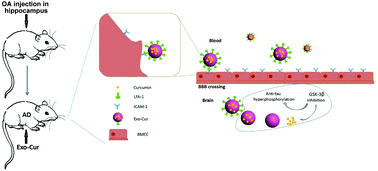Curcumin-primed exosomes potently ameliorate cognitive function in AD mice by inhibiting hyperphosphorylation of the Tau protein through the AKT/GSK-3β pathway
Abstract
Alzheimer's disease (AD) is the progressive development of fatal neurodegenerative diseases. Owing to the unclearness of the pathogenesis of AD and the failure of the drug to cross the blood–brain barrier (BBB), there is currently a lack of effective diagnostic and therapeutic approaches in the treatment of AD. The aim of this study was to design exosomes (Exo) as a specifically designed carrier able to carry curcumin (cur) to prevent neuronal death in vitro and in vivo to alleviate the AD symptoms. Our results demonstrated that Exo improved the solubility and bioavailability of cur and increased drug penetration across the BBB by specific active targeting between Exo, inheriting the lymphocyte function-associated antigen 1 (LFA-1) and endothelial intercellular adhesion molecule 1 (ICAM-1). Exosomes derived from curcumin-treated (primed) cells (Exo-cur) can better prevent the death of neurons in vitro and in vivo to relieve the symptoms of AD by inhibiting phosphorylation of the Tau protein through activating the AKT/GSK-3β pathway. Our results suggested that Exo-cur featured highly effective BBB-crossing via receptor-mediated transcytosis to access brain tissues and inhibited Tau phosphorylation, holding great potential in improving targeted drug delivery and the recovery of neuronal function in AD therapy.



 Please wait while we load your content...
Please wait while we load your content...